Affiliate links on Android Authority may earn us a commission. Learn more.
Google Pixel 7 and Pixel 7 Pro hands-on impressions: Staying consistent
It’s been a whirlwind ride over the past few months as Google Pixel 7 and Pixel 7 Pro leaks gushed out at a relentless pace. Now, though, Google has finally lifted the veil and told us everything there is to know about the Pixel 7 phones — and we briefly got our hands on both of them at Google’s Brooklyn and Paris launch events.
Has Google made enough changes this year to merit the existence of these devices? Let’s check them out.

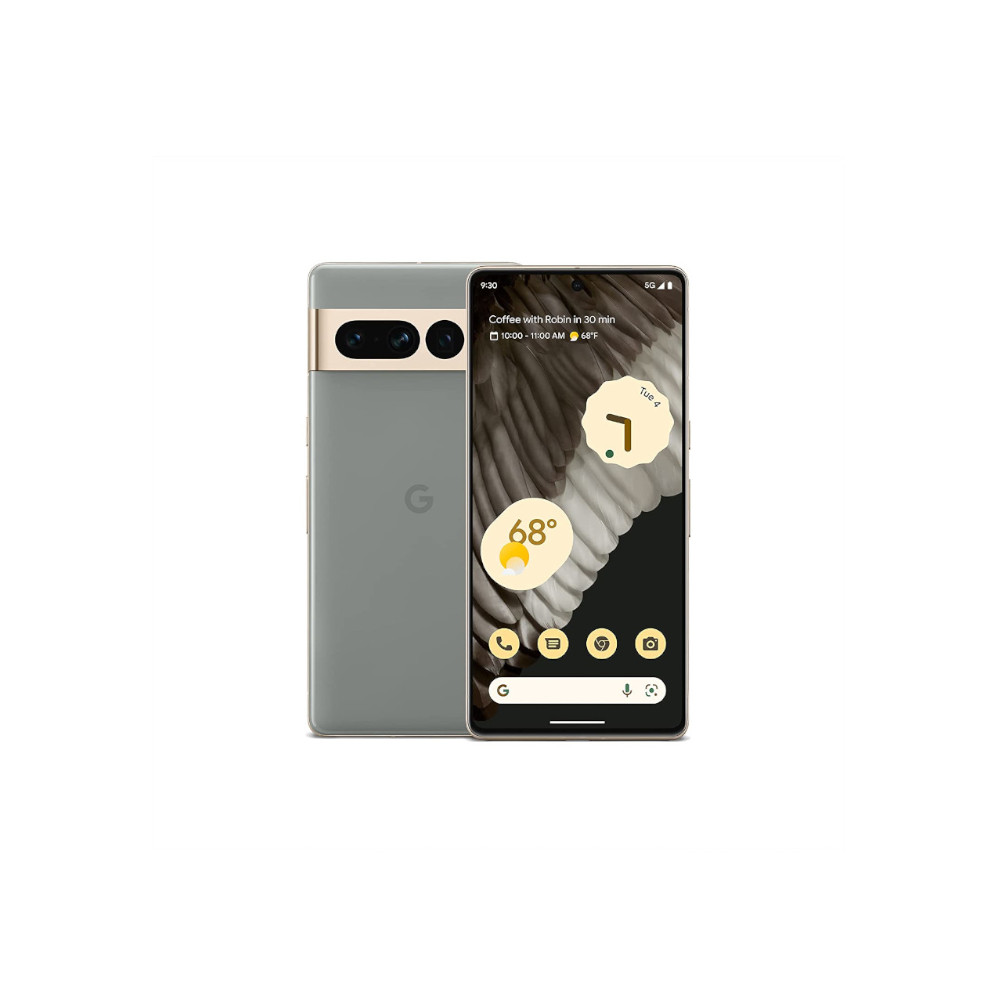
High-quality display
Big battery
If it ain’t broke…
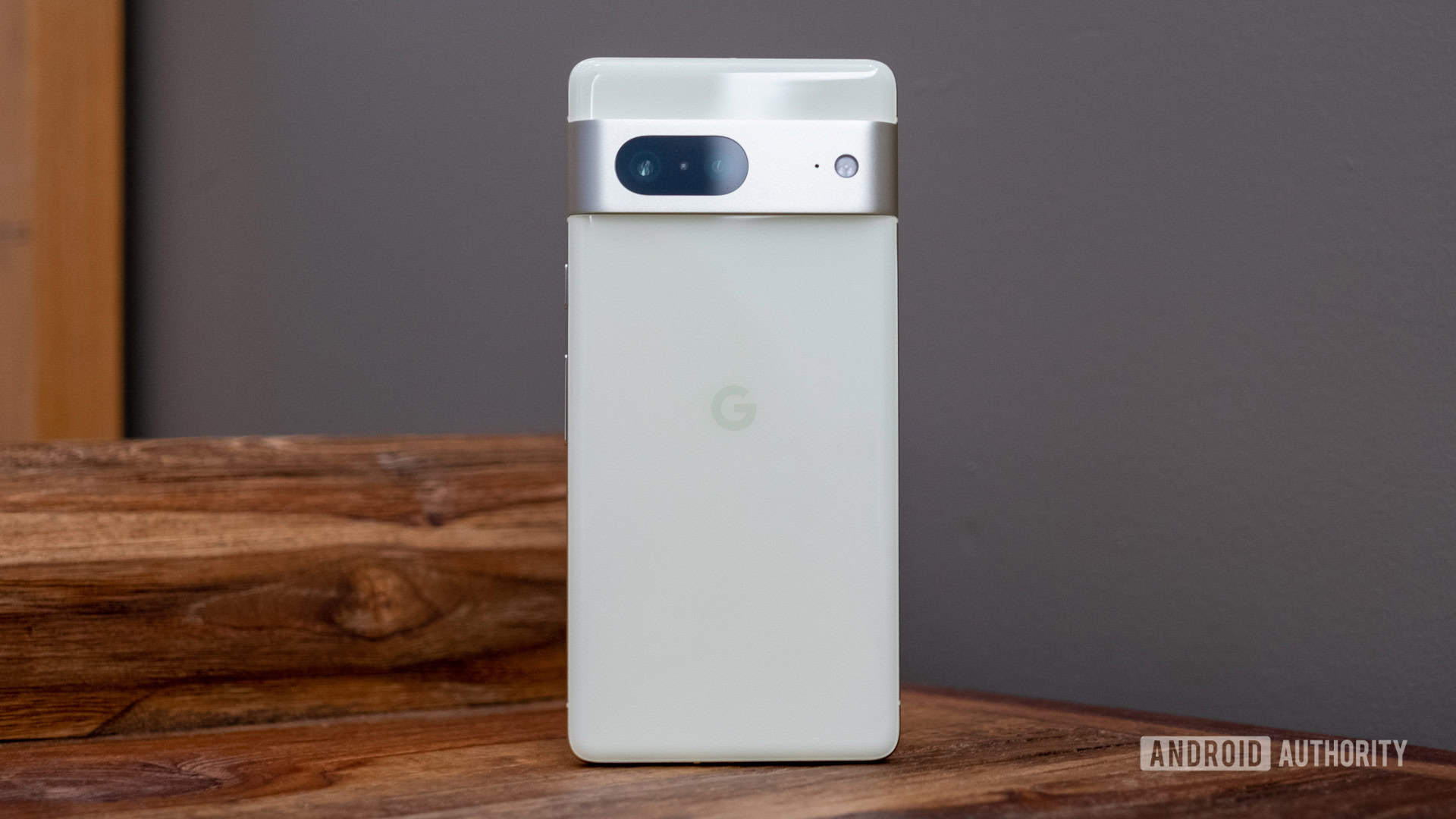
If you loved the design of the Pixel 6 series, I have good news. If you hated the design of the Pixel 6 series, I have bad news. While Google made plenty of design alterations this time around, the overall look and feel of the Pixel 7 series strongly align with the Pixel 6 series. There are plenty of differences, to be certain, but the combined parts make for a very similar whole.
One of the biggest differences is that the Pixel 7 is smaller than the Pixel 6. By raw measurements, it might not seem like much: 155.6 x 73.2 x 8.7mm for the Pixel 7 compared to 158.6 x 74.8 x 8.9mm for the Pixel 6. But you can immediately feel the difference in your hand. It feels lighter and a bit more compact. There’s a major dearth of compact phones in the Android world, so it’s nice to see another option.
The Pixel 7 feels smaller than the Pixel 6, while the Pixel 7 Pro feels mostly the same as the Pixel 6 Pro.
The Pixel 7 Pro, on the other hand, feels about the same. Its dimensions are 162.9 x 76.6 x 8.9mm, which isn’t too far off from the Pixel 6 Pro’s dimensions of 163.9 x 75.9 x 8.9mm. The curved sides do feel a bit more subtle this year, but that could just be my imagination wanting that to be true. Regardless, the Pixel 7 Pro still feels big, heavy, and curvy.
Both phones also feel tightly constructed and premium. The aluminum rails are matte on the Pixel 7 and polished on the Pixel 7 Pro, but both styles feel great in the hand. The buttons are solid and clicky. Interestingly, the design of the buttons clashes with the rail, meaning the buttons on the vanilla Pixel 7 are polished and the buttons on the Pixel 7 Pro are matte. It looks good and makes it easy to find the buttons without needing to look.
All glass used on all models is Gorilla Glass Victus this year, which should make them more durable overall, and each device has a full IP68 rating to help keep them safe from water and debris.
Finally, Google is introducing some new colorways with the Pixel 7 series. Obsidian — which is available for the Pixel 7 and the Pixel 7 Pro — is ostensibly black, although it looks more like a dark gray in person. Snow is also available for both models and it is a calming white that looks pretty classy. The Pixel 7 has a unique color in Lemongrass, which is a soft yellow with greenish undertones. Hazel is the Pixel 7 Pro’s unique colorway, which looks like a grayish green. Based on our limited time with the pair, the Obsidian model is a fingerprint magnet while the Lemongrass model fares much better.
Overall, these new colorways show Google reigning in its ambitions a bit this year. The Pixel 6 series had a lot of fun colors, but they may have been a bit too wild for the average buyer. Offering classy-but-neutral black and white models for each variant will please folks who don’t want their phones to be fashion statements, but more adventurous customers can go for the Lemongrass and Hazel models.
Keep in mind, each colorway has a unique camera bar style, but that deserves its own section.
The new camera bar
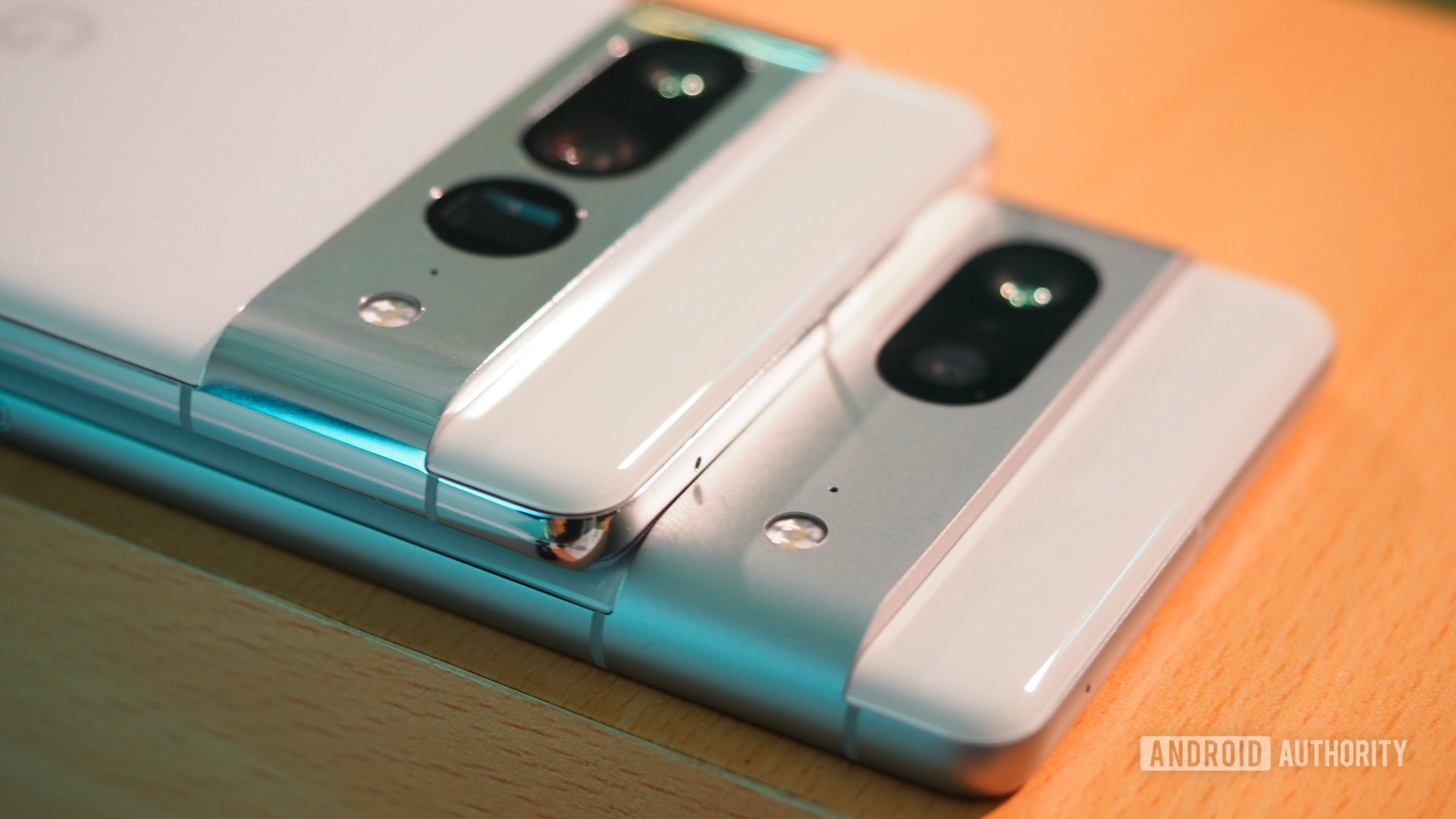
Most of the design elements of the Pixel 7 phones carry over from the Pixel 6 series. That’s not true of the camera bar, though, which looks very different on the 2022 models.
This year, the camera bar on all models is covered with aluminum rather than glass. This results in a wholly different look for the back of the phone.
Since the rails of the phones are also aluminum, this creates a consistent design ethos that goes all around the device. I think Google made the right move here, as the metal bar has a certain elegance the all-black-all-the-time camera bar lacked, and the rails matching the camera bar make the phone feel a bit less disjointed.
The camera bar also changes with each colorway. On Obsidian models, it is a dark silver — think polished nickel for the Pro and unpolished nickel for the regular model. Meanwhile, Snow models get a brighter silver reminiscent of chrome. Hazel and Lemongrass models get a bar that has the look of brass.
Google swapped out glass for aluminum on the camera bar this year, and it looks sweet.
Because the camera bar is covered with metal now, the camera lenses themselves have distinct cutouts. There is one pill-shaped cutout for the Pixel 7 that houses its 50MP wide lens and its 12MP ultrawide lens right next to it. These sensors are unchanged from last year. The Pixel 7 Pro has that same pill-shaped cutout with the same 50MP wide lens, but the 12MP ultrawide is slightly different with a wider field of view than we’ve ever seen on a Pixel before at 125.8 degrees. Next to this cutout is another circular cutout for the 48MP telephoto lens, which also has some upgrades that allow it to get 5x optical zoom.
The camera bar is likely to still be a controversial design, considering it looks different from everything else on the market. However, I think the 2022 manifestation of the camera bar looks terrific and I’m glad to see Google is sticking with the groundwork it created with the Pixel 6 series. After all, Google has historically had a lot of problems with keeping things consistent.
Brighter and better displays?
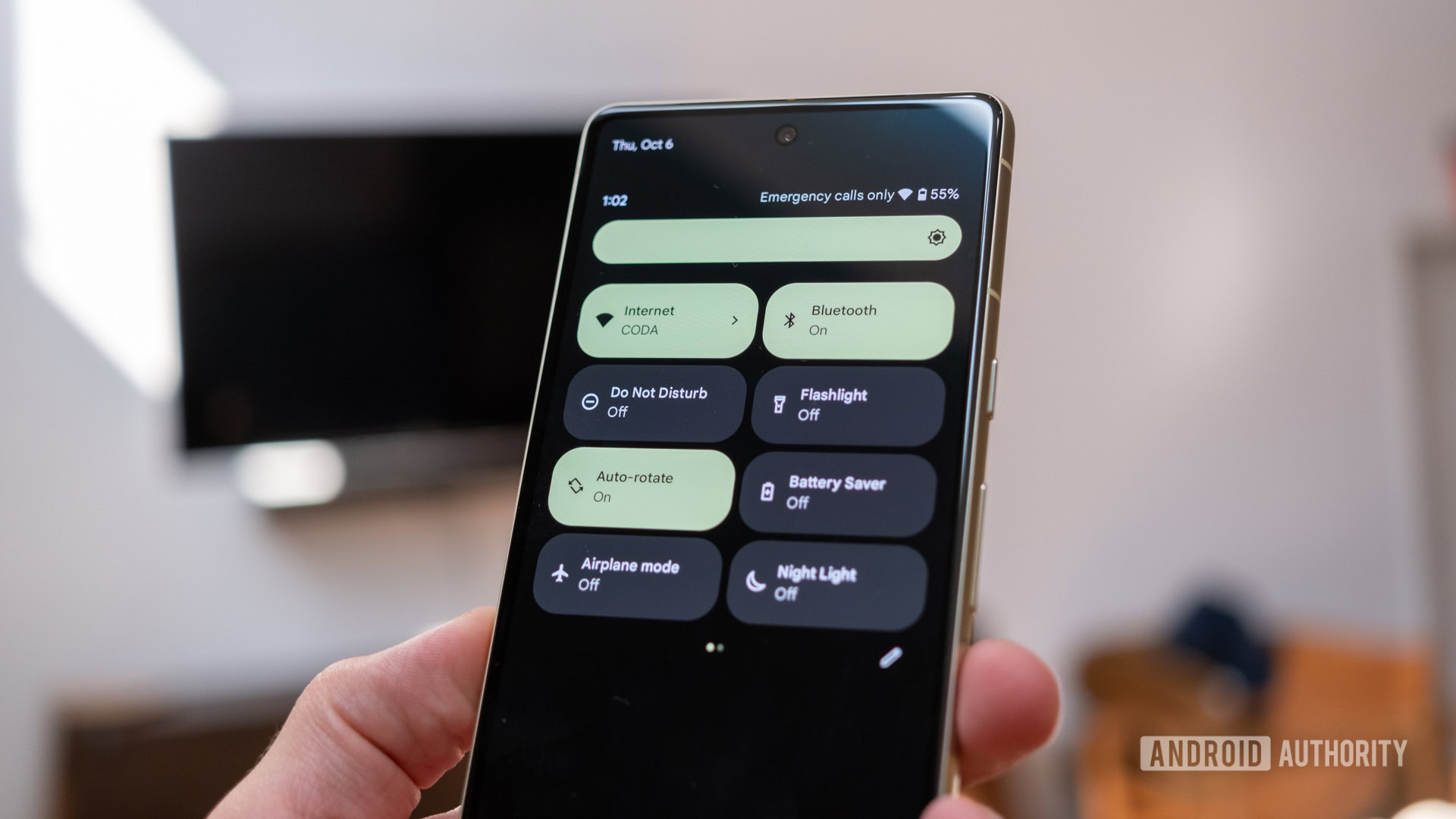
With the Pixel 7 Pro, the overall dimensions of the phone may have changed, but the screen mostly hasn’t. By nearly all metrics, this is the exact same display we saw in the Pixel 6 Pro, right down to the same resolution, refresh rate, pixel density, aspect ratio, and diagonally measured size of 6.71 inches.
The one difference, though, is that the Pixel 7 Pro is capable of hitting an advertised brightness of 1,500 nits. That’s significantly brighter than the Pixel 6 Pro — almost twice as bright, actually. Of course, advertised peak brightnesses rarely match real-world levels, but that significant jump in brightness can be immediately seen when you use the Pixel 7 Pro.
The displays are mostly the same in 2022, but they are much, much brighter.
Meanwhile, the vanilla Pixel 7 has more changes to its display than the Pixel 7 Pro. The display is a bit smaller: 6.32 inches this year as compared to 6.4 inches last year. Because the display reduced in size but the resolution stayed the same (2,400 x 1,080), the pixel density is a bit higher at 416ppi. I couldn’t tell a difference just by looking at it, but I did immediately notice how much brighter it is. The Pixel 7 has an advertised peak brightness of 1,400 nits, so slightly below that of the Pixel 7 Pro. This is significantly brighter than the Pixel 6, which maxed out at the same 800 nits as the Pixel 6 Pro.
The selfie cutouts are also the same, but they house a much different camera.
At the top of each display is a centered selfie camera cutout. The cutout isn’t much different from the previous models: it’s in the same spot and pretty much the same size. However, that cutout on both the Google Pixel 7 and Pixel 7 Pro houses a new 10.8MP ultrawide sensor. This gives you a wider field of view at 92.8 degrees, which will be perfect for group selfies. The sensor itself is also newer and better than the previous model, so selfies should see a nice uptick this year.
Tensor G2: The same but different
The Tensor G2 chipset powering the Pixel 7 and Pixel 7 Pro is only the second-ever custom processor from Google. One would think that would mean Tensor G2 would be much more advanced than the original Tensor. However, this would be both a true and untrue statement depending on how you look at it.
To be clear, Tensor G2 has nearly the same architecture as the old Tensor. It’s based on the same 5nm process and even has the same 2+2+4 configuration, though the two Cortex-A76s in the original Tensor have been swapped for two Cortex-A78s. The major things Google altered were the Tensor processing unit (TPU), the GPU, and the modem.
Let’s start with the TPU, which is specifically designed for neural network machine learning. Essentially, this is where Google stuffs all the software smarts that help Pixels do their many camera software tricks, such as Magic Eraser, improved Super Res Zoom (now up to 30x), and the new Photo Unblur feature, which does exactly what it sounds like (and is exclusive to the Pixel 7 series). The TPU on Tensor G2 is also faster and more efficient. Google claims it is up to 60% faster based on speech and camera workloads as compared to the original Tensor.
The GPU has been upgraded from a Mali-G78 MP20 to a Mali-G710 MP07. This is the same GPU that appears on the MediaTek Dimensity 9000, though Google’s version only has seven cores (MediaTek’s has 10). It’s certainly an upgrade, but we’ll have to stress test it to see whether it’s a notable improvement.
As for the modem, Google did confirm it has been upgraded. It did not, however, confirm the new model. Here’s hoping it avoids the networking issues many encountered with the Pixel 6 series.
There's still a lot we don't know about Tensor G2.
While the Tensor G2 may not be making any leaps in terms of raw power, it’s not unlike Google to instead rely on bespoke hardware and software to make real-world usage better. Although enthusiasts might be miffed they can’t have both. Fundamentally though, the Tensor G2 is different — just not different in the ways we usually look for when it comes to new chipsets.
Of course, we’ll need to put Tensor G2 through our usual rounds of testing, but it does appear that at least some of the pain points of the original Tensor could be made better with this new model. We’ll need to wait and see how this plays out.
Anything else?
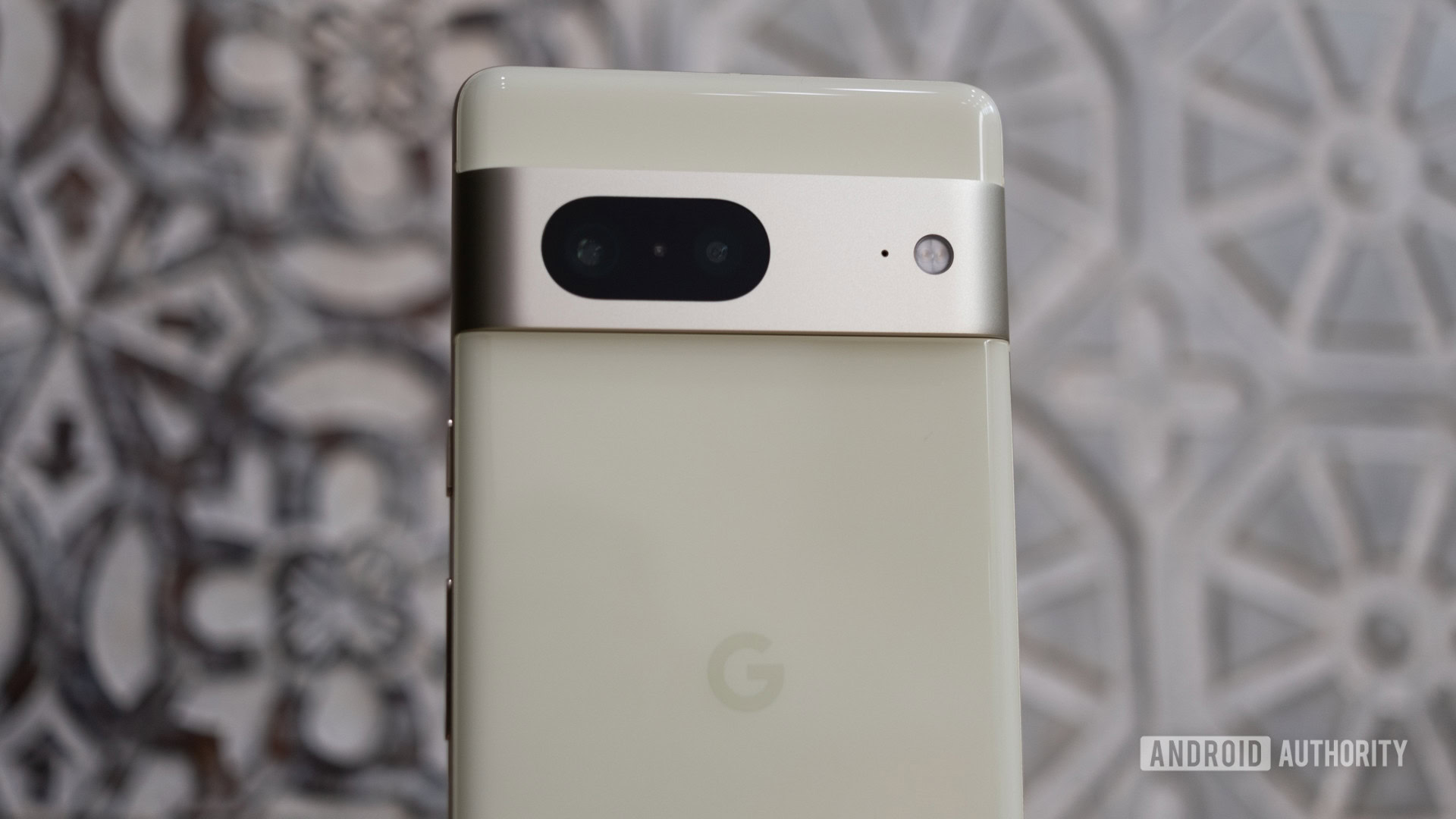
- Face Unlock: For the first time on a Pixel since the Pixel 4, the Pixel 7 series supports Face Unlock. However, it is not a true biometric like we saw on the Pixel 4 phones. You can use this new version of Face Unlock to unlock the phone but not for approving things like contactless payments. You’ll need to stick with the fingerprint sensor or your PIN for that.
- Same update commitment: With the Pixel 6 series, Google upped its commitment for software updates. It now offers five years of security updates and three Android upgrades. We hoped Google would increase this again this year to match Samsung, which offers four Android upgrades and five years of patches. That didn’t happen, though, so the Pixel 7 series gets the same three upgrades as last year.
- No charging upgrades: The Pixel 7 series will charge both wired and wirelessly at the same rates as the Pixel 6 series. That means 30W wired for both phones, 21W wireless for the Pixel 7, and 23W wireless for the Pixel 7 Pro. In the overall industry, these speeds are nothing special.
- Batteries: The Pixel 7 Pro has the same battery capacity as last year (5,000mAh). However, the Pixel 7 has a slightly smaller battery this year (4,355mAh), a loss of about 6% capacity.
Google Pixel 7 and 7 Pro specs
| Pixel 7 | Pixel 7 Pro | |
|---|---|---|
Display | Pixel 7 6.32 inch 2,400 x 1,080 pixels 1,400 nits 90Hz OLED | Pixel 7 Pro 6.7 inch 3,120 x 1,440 pixels 1,500 nits 120Hz pOLED |
Processor | Pixel 7 Tensor G2 | Pixel 7 Pro Tensor G2 |
RAM | Pixel 7 8GB | Pixel 7 Pro 12GB |
Storage | Pixel 7 128GB / 256GB | Pixel 7 Pro 128GB / 256GB |
Power | Pixel 7 4,355mAh Li-Ion Wireless charging up to 72 hours of runtime with Extreme Battery Saver | Pixel 7 Pro 5,000mAh Li-Ion Wireless charging up to 72 hours runtime with Extreme Battery Saver |
Cameras | Pixel 7 Rear: - 50MP main 1.2 μm, ƒ/1.85, 82-degree FoV 1/1.31-inch sensor OIS and EIS - 12MP ultrawide 1.25 μm, ƒ/2.2, 114-degree FoV - Laser AF Front: - 10.8MP 1.22 μm, ƒ/2.2, 92.8-degree FoV | Pixel 7 Pro Rear: - 50MP main 1.2 μm, ƒ/1.85, 82-degree FoV 1/1.31-inch sensor OIS and EIS - 12MP ultrawide 1.25 μm, ƒ/2.2, 125.8-degree FoV, autofocus - 48MP telephoto 0.7 μm, ƒ/3.5, 20.6-degree FoV OIS 5x optical zoom, 30x Super Resolution - Laser AF Front: - 10.8MP 1.22 μm, ƒ/2.2, 92.8-degree FoV |
Connectivity | Pixel 7 2G, 3G, 4G, 5G Bluetooth 5.2 NFC Wi-Fi 802.11ax | Pixel 7 Pro 2G, 3G, 4G, 5G Bluetooth 5.2 NFC Wi-Fi 802.11ax |
Dimensions | Pixel 7 155.64 x 73.16 x 8.7mm | Pixel 7 Pro 162.9 x 76.55 x 8.9mm |
Software | Pixel 7 Android 13 | Pixel 7 Pro Android 13 |
Durability | Pixel 7 IP68 | Pixel 7 Pro IP68 |
Google Pixel 7 and Pixel 7 Pro: Our early verdict
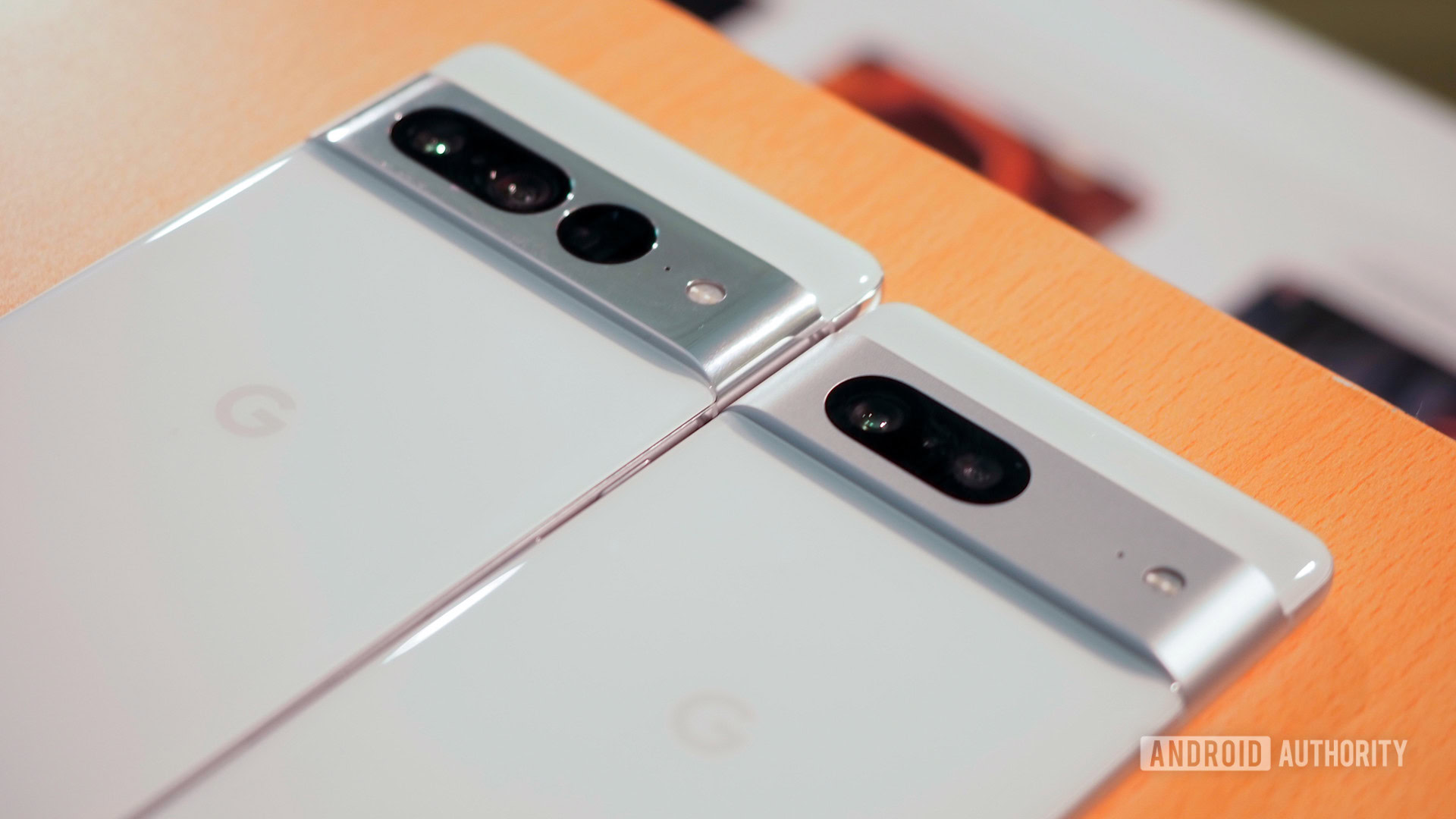
The Google Pixel 7 and Pixel 7 Pro seem like very iterative upgrades over the Pixel 6 series, though they do look a little different, have an upgraded processor, and feature some new camera hardware.
If Google did this and tried to ask for more money, it might be a hard sell. Thankfully, the company is leaving pricing the same. The Pixel 7 starts at $599 while the Pixel 7 Pro starts at $899. These were terrific prices in 2021 and they’re still great in 2022.
The Pixel 7 and Pixel 7 Pro stay the course from the Pixel 6 series and add some welcome upgrades to the formula.
Although we haven’t properly tested these phones yet, my limited time with them suggests that Google might have another set of winners on its hands. The price-to-value ratio is superb and these seem like better phones than the Pixel 6 series — just only nominally better.
It does not seem like folks with a Pixel 6 or Pixel 6 Pro need to worry about upgrading, though. While these new phones look nice and have some neat perks, I can’t see enough here to make a one-year upgrade necessary or even advisable. If you skipped the Pixel 6 series while waiting for Google to refine them a bit, though, then you should get excited.
There’s plenty we’re eager to test, so stay tuned for full Pixel 7 and Pixel 7 Pro reviews coming soon.



